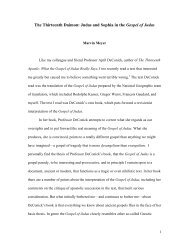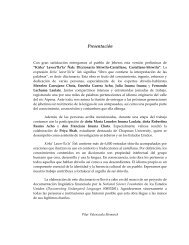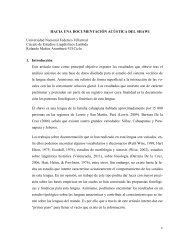“Surplus Humanity” and the Margins of Legality - Chapman University
“Surplus Humanity” and the Margins of Legality - Chapman University
“Surplus Humanity” and the Margins of Legality - Chapman University
You also want an ePaper? Increase the reach of your titles
YUMPU automatically turns print PDFs into web optimized ePapers that Google loves.
Do Not Delete 12/12/2010 7:34 PM<br />
24 <strong>Chapman</strong> Law Review [Vol. 14:1<br />
Liberalization <strong>and</strong> deregulation <strong>of</strong> economies have also<br />
accelerated urban occupational marginality, with <strong>the</strong> result that<br />
those engaged in <strong>the</strong> informal sector now constitute two-fifths <strong>of</strong><br />
<strong>the</strong> economically active population <strong>of</strong> <strong>the</strong> developing countries. 150<br />
―The International Labour Organization estimates that informal<br />
workers comprise over half <strong>the</strong> workforce in Latin America, over<br />
70 per cent in Sub-Saharan Africa <strong>and</strong> over 80 per cent in<br />
India . . . .‖ 151 Across <strong>the</strong> global South, mega-slums ―have become<br />
a dumping ground for a surplus population working in unskilled,<br />
unprotected <strong>and</strong> low-wage informal service industries <strong>and</strong><br />
trade.‖ 152 Rural <strong>and</strong> urban areas are being sutured in production<br />
networks to accelerate siphoning <strong>of</strong> value. 153 As outsourcing <strong>and</strong><br />
flexible production shrink <strong>the</strong> regulated formal economy, <strong>the</strong><br />
informal shadow economy becomes <strong>the</strong> only hope <strong>and</strong> source <strong>of</strong><br />
livelihood for <strong>the</strong> urban poor. The explosive expansion <strong>of</strong> <strong>the</strong><br />
unregulated informal sector, with its particular burdens on<br />
women is ―a direct function <strong>of</strong> liberalization.‖ 154 Over <strong>the</strong> last<br />
twenty years, both <strong>the</strong> informal economies <strong>and</strong> <strong>the</strong> number <strong>of</strong><br />
slum-dwellers have grown exponentially. 155 In India, as in most<br />
<strong>of</strong> <strong>the</strong> global South, significant employment growth has resulted<br />
from subcontracting at a global scale <strong>and</strong> <strong>the</strong> use <strong>of</strong> casual or<br />
150 UN-HABITAT, THE CHALLENGE OF SLUMS, supra note 10, at 46, 103–04 (2003).<br />
Note here that many working in <strong>the</strong> informal sector are a hidden workforce <strong>of</strong> <strong>the</strong> formal<br />
economy. Outsourcing <strong>and</strong> subcontracting networks enable <strong>the</strong> value created by <strong>the</strong><br />
informal sector to be funneled into <strong>the</strong> pr<strong>of</strong>it margins <strong>of</strong> <strong>the</strong> formal sector, while any<br />
expectation <strong>of</strong> ―upward mobility‖ in <strong>the</strong> informal sector remains a ―myth inspire by<br />
wishful thinking.‖ JAN BREMAN, THE LABOURING POOR IN INDIA: PATTERNS OF<br />
EXPLOITATION, SUBORDINATION, AND EXCLUSION 173–74 (2003).<br />
151 Jan Breman, Myth <strong>of</strong> <strong>the</strong> Global Safety Net, 59 NEW LEFT REV. 29, 29 (2009).<br />
152 UN-HABITAT, THE CHALLENGE OF THE SLUMS, supra note 10, at 46. Women make<br />
up ninety percent <strong>of</strong> <strong>the</strong> workers in Free Trade Zones, notorious for dismal working<br />
conditions, low wages, <strong>and</strong> absence <strong>of</strong> workers‘ rights. Id. at 40; WOMEN‘S EDGE<br />
COALITION, THE EFFECTS OF TRADE LIBERALIZATION ON JAMAICA‘S POOR: AN ANALYSIS OF<br />
AGRICULTURE AND SERVICES 31 (2004). Privatization <strong>and</strong> erasure <strong>of</strong> trade barriers led to<br />
widespread deindustrialization <strong>and</strong> decimation <strong>of</strong> formal-sector jobs that traditionally<br />
employed men. This has increasingly forced poor women into unregulated <strong>and</strong> low-paying<br />
informal sector as pieceworkers, vendors, <strong>and</strong> providers <strong>of</strong> low-end services. See Caroline<br />
O. N. Moser, Adjustment from Below: Low-Income Women, Time <strong>and</strong> <strong>the</strong> Triple Role in<br />
Guayaquil, Ecuador, in ‗VIVA‘: WOMEN AND POPULAR PROTEST IN LATIN AMERICA 173,<br />
180–82 (Sarah A. Radcliffe & Sallie Westwood eds., 1993); Nazneen Kanji, Gender,<br />
Poverty <strong>and</strong> Economic Adjustment in Harare, Zimbabwe, 7 ENV‘T & URBANIZATION 37, 37,<br />
39, 46–48 (1995).<br />
153 See PETER J. TAYLOR, WORLD CITY NETWORK: A GLOBAL URBAN ANALYSIS 60–61<br />
(2004); John Friedmann, Where We St<strong>and</strong>: A Decade <strong>of</strong> World City Research, in WORLD<br />
CITIES IN A WORLD–SYSTEM 21, 21, 33, 41 (Paul L. Knox & Peter J. Taylor eds., 1995);<br />
Julie Skurski & Fern<strong>and</strong>o Coronil, Country <strong>and</strong> City in a Postcolonial L<strong>and</strong>scape: Double<br />
Discourse <strong>and</strong> <strong>the</strong> Geo-Politics <strong>of</strong> Truth in Latin America, in VIEWS BEYOND THE BORDER<br />
COUNTRY: RAYMOND WILLIAMS AND CULTURAL POLITICS 231, 232–33 (Dennis L. Dworkin<br />
& Leslie G. Roman eds., 1993).<br />
154 UN-HABITAT, THE CHALLENGE OF SLUMS, supra note 10, at 40.<br />
155 Id. at 6, 11.
















